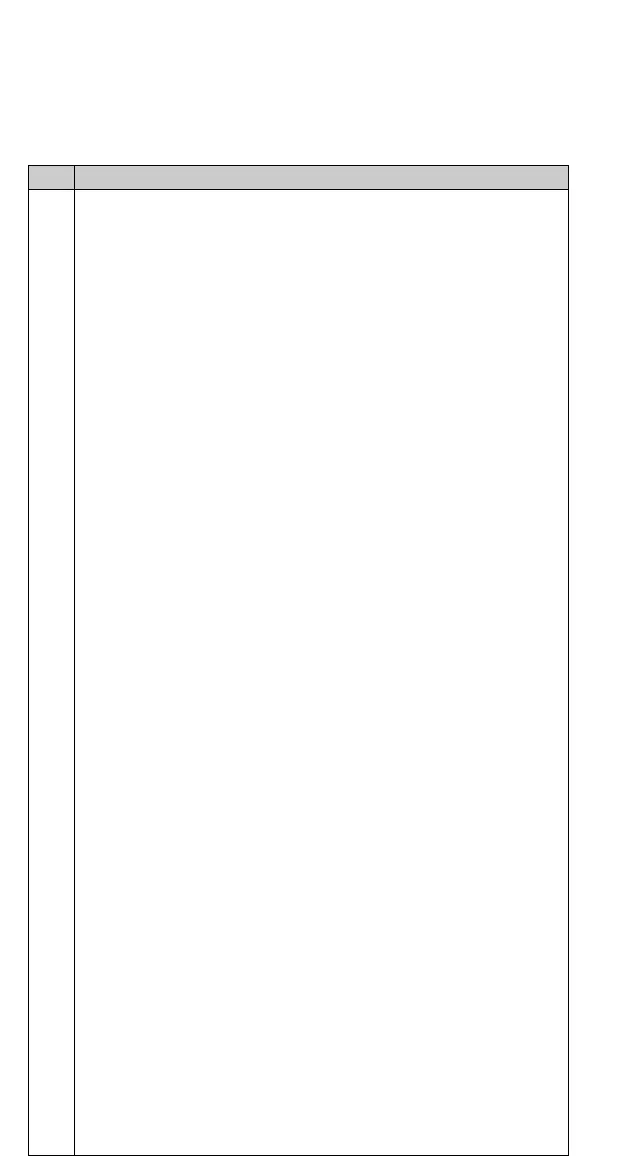47
Group 10: Command Inputs
Start, Stop and Direction commands can be given from the control panel or
from two external locations (
EXT1, EXT2). The selection between the two
external locations is made with parameter 1102
EXT1/EXT2 SEL. For more
information on control locations refer to “APPENDIX” on page 93.
Code Description
1001 EXT1 COMMANDS
Defines the connections and the source of Start/Stop/Direction commands for
External control location 1 (
EXT1).
0 =
NOT SEL
No Start/Stop/Direction command source for EXT1 is selected.
1 = DI1
Two-wire Start/Stop connected to digital input DI1. DI1 deactivated = Stop;
DI1 activated = Start. *
2 = DI1,2
Two-wire Start/Stop, Direction. Start/Stop is connected to digital input DI1 as
above. Direction is connected to digital input DI2. DI2 deactivated = Forward;
DI2 activated = Reverse. To control direction, value of parameter 1003
DIRECTION should be REQUEST.
3 = DI1P,2P
Three-wire Start/Stop. Start/Stop commands are given by means of momentary
push-buttons (the P stands for “pulse”). The Start push-button is normally open,
and connected to digital input DI1. The Stop push-button is normally closed, and
connected to digital input DI2. Multiple Start push-buttons are connected in
parallel; multiple Stop push-buttons are connected in series. *,**
4 = DI1P,2P,3
Three-wire Start/Stop, Direction. Start/Stop connected as with DI1P,2P. Direction
is connected to digital input DI3. DI3 deactivated = Forward; DI3 activated =
Reverse. To control Direction, value of parameter 1003 D
IRECTION should be
REQUEST. **
5 = DI1P,2P,3P
Start Forward, Start Reverse, and Stop. Start and Direction commands are given
simultaneously with two separate momentary push-buttons (the P stands for
“pulse”). The Stop push-button is normally closed, and connected to digital input
DI3. The Start Forward and Start Reverse push-buttons are normally open, and
connected to digital inputs DI1 and DI2 respectively. Multiple Start push-buttons
are connected in parallel, and multiple Stop push-buttons are connected in
series. To control direction, value of parameter 1003
DIRECTION should be
REQUEST. **
6 = DI5
Two-wire Start/Stop, connected to digital input DI5. DI5 deactivated = Stop and
DI5 activated = Start. *
7 = DI5,4
Two-wire Start/Stop/Direction. Start/Stop is connected to digital input DI5.
Direction is connected to digital input DI4. DI4 deactivated = Forward and DI4
activated = Reverse. To control direction, value of parameter 1003
DIRECTION
should be
REQUEST.
8 =
KEYPAD
The Start/Stop and Direction commands are given from the control panel when
External control location 1 is active. To control direction, value of parameter
1003
DIRECTION should be REQUEST.
9 =
DI1F,2R
Start forward command is given when DI1 is activated and DI2 is deactivated.
Start reverse command is given if DI1 is deactivated and DI2 is activated. In
other cases Stop command is given.
10 =
COMM
The Start/Stop and Direction commands are given through serial
communication.
*Note! In cases 1,3,6 direction is set with parameter 1003
DIRECTION. Selecting
value 3 (
REQUEST) fixes direction to Forward.
**Note! Stop signal must be activated before Start command can be given.
www.barghmaher.org
